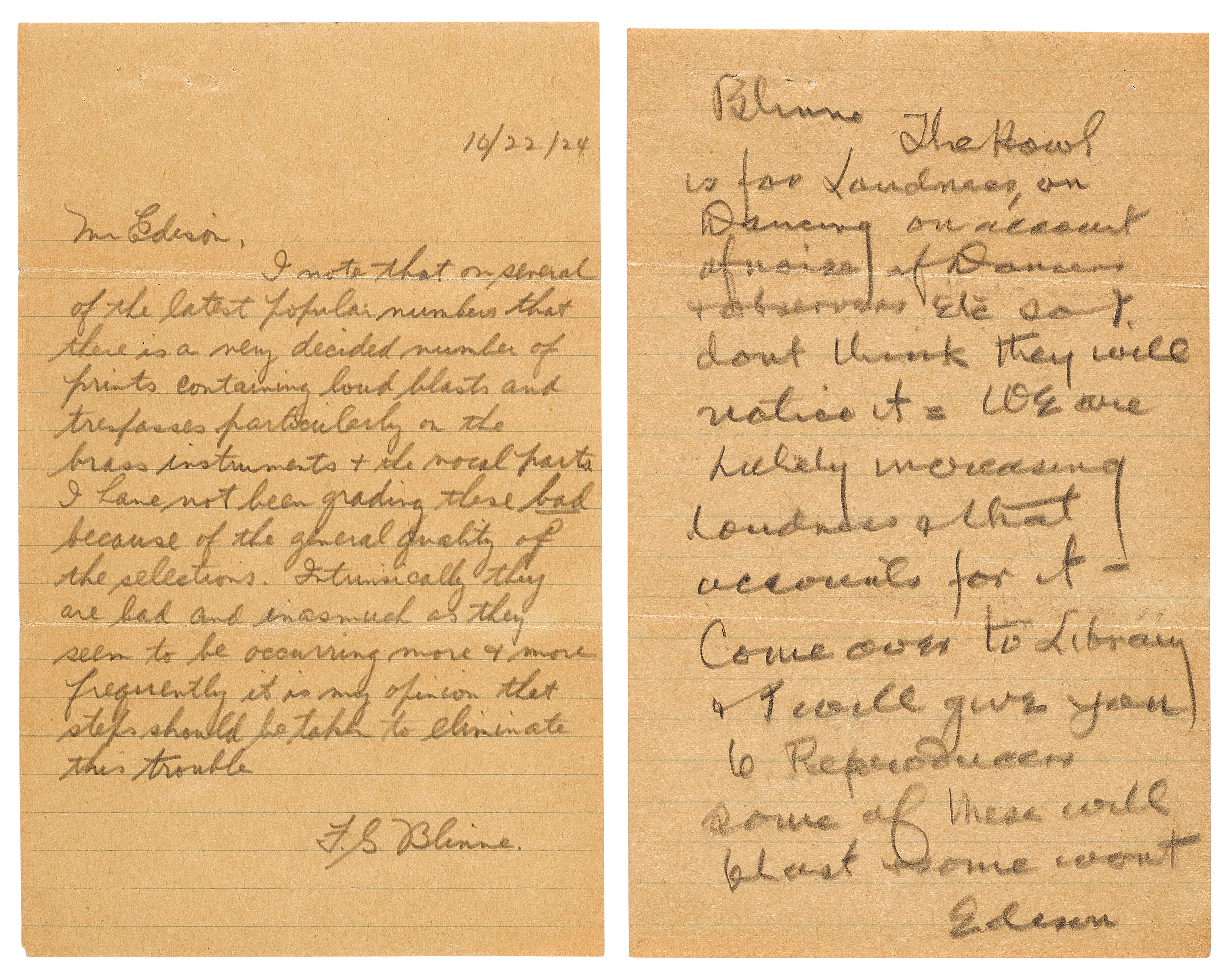EDISON, THOMAS ALVA. Autograph letter signed ("E" at end and at top of first page) TO HIS PARTNER, THE INVENTOR R.H. BEACH, n.p. [Fort Myers, Florida?], l9 April [l9l0?]. 6 pages, 8vo, in dark pencil on Edison's typical yellow lined note-paper, written on rectos only. PLANNING THE EDISON-BEACH ELECTRIC-POWERED CAR Employing Edison's very successful storage batteries designed for use in automobiles, Edison and Beach planned to build a self-propelled trolley car which would reduce"the unnecessary consumption of power," and perhaps even compete with the steam-powered locomotive. At this time, Beach was in New York testing a prototype on 59th Street, while they modified their design to improve its efficiency. Edison notes at the top of his first page: "Beach, here are a few figures rapidly made upon receiving your letter...perhaps I have made some errors, go over the subject yourself & you will realize the importance of light weight battery." Continuing with his detailed specifications, Edison points out that "it requires a pound of car to carry a pound of battery or passenger or removable material. The parts of the car will be under a certain strain...due to the weight...The only safe thing to do when you add a pound of weight of any kind is that a pound should be addred to the car. Very few have attained this." Edison then considers several progressively larger batteries, rating their weight and output proportional to the car's weight and rejecting each in turn as inadequate for the Edison-Beach car. Finally, he calculates that "with an honest built [i.e. sturdily made] car, 17 plate exide is the smallest battery that will do the work....Where these Lead people will fool the RR people is in overloading the car with extra weight, the battery must be kept up for 5 cents car mile but how about extra strains & wear, the RR men cant see this until too late. However if RR people have right Eng[inee]rs they will not be fooled....I would have been a fool to have worked 7 yrs. and expended nearly 2 million [dollars] to get the weight down to half...if I did not know what was required to solve vehicle traction in Cities in a Commercial way....You will see what an important thing reduction in weight is in batteries." An earlier letter of Edison's, dated 5 April l9l0, also regarding the Edison-Beach car, was sold in these rooms 7 December l990, lot 160.
EDISON, THOMAS ALVA. Autograph letter signed ("E" at end and at top of first page) TO HIS PARTNER, THE INVENTOR R.H. BEACH, n.p. [Fort Myers, Florida?], l9 April [l9l0?]. 6 pages, 8vo, in dark pencil on Edison's typical yellow lined note-paper, written on rectos only. PLANNING THE EDISON-BEACH ELECTRIC-POWERED CAR Employing Edison's very successful storage batteries designed for use in automobiles, Edison and Beach planned to build a self-propelled trolley car which would reduce"the unnecessary consumption of power," and perhaps even compete with the steam-powered locomotive. At this time, Beach was in New York testing a prototype on 59th Street, while they modified their design to improve its efficiency. Edison notes at the top of his first page: "Beach, here are a few figures rapidly made upon receiving your letter...perhaps I have made some errors, go over the subject yourself & you will realize the importance of light weight battery." Continuing with his detailed specifications, Edison points out that "it requires a pound of car to carry a pound of battery or passenger or removable material. The parts of the car will be under a certain strain...due to the weight...The only safe thing to do when you add a pound of weight of any kind is that a pound should be addred to the car. Very few have attained this." Edison then considers several progressively larger batteries, rating their weight and output proportional to the car's weight and rejecting each in turn as inadequate for the Edison-Beach car. Finally, he calculates that "with an honest built [i.e. sturdily made] car, 17 plate exide is the smallest battery that will do the work....Where these Lead people will fool the RR people is in overloading the car with extra weight, the battery must be kept up for 5 cents car mile but how about extra strains & wear, the RR men cant see this until too late. However if RR people have right Eng[inee]rs they will not be fooled....I would have been a fool to have worked 7 yrs. and expended nearly 2 million [dollars] to get the weight down to half...if I did not know what was required to solve vehicle traction in Cities in a Commercial way....You will see what an important thing reduction in weight is in batteries." An earlier letter of Edison's, dated 5 April l9l0, also regarding the Edison-Beach car, was sold in these rooms 7 December l990, lot 160.











.jpg)



Try LotSearch and its premium features for 7 days - without any costs!
Be notified automatically about new items in upcoming auctions.
Create an alert